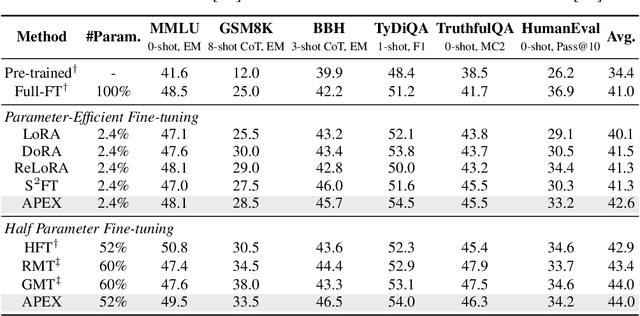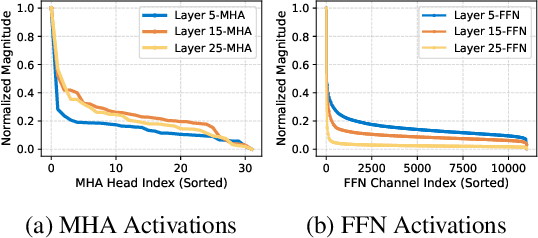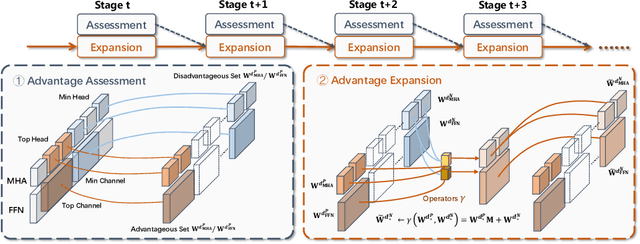Zhenyu Zhang
HD3C: Efficient Medical Data Classification for Embedded Devices
Sep 18, 2025Abstract:Energy-efficient medical data classification is essential for modern disease screening, particularly in home and field healthcare where embedded devices are prevalent. While deep learning models achieve state-of-the-art accuracy, their substantial energy consumption and reliance on GPUs limit deployment on such platforms. We present Hyperdimensional Computing with Class-Wise Clustering (HD3C), a lightweight classification framework designed for low-power environments. HD3C encodes data into high-dimensional hypervectors, aggregates them into multiple cluster-specific prototypes, and performs classification through similarity search in hyperspace. We evaluate HD3C across three medical classification tasks; on heart sound classification, HD3C is $350\times$ more energy-efficient than Bayesian ResNet with less than 1% accuracy difference. Moreover, HD3C demonstrates exceptional robustness to noise, limited training data, and hardware error, supported by both theoretical analysis and empirical results, highlighting its potential for reliable deployment in real-world settings. Code is available at https://github.com/jianglanwei/HD3C.
Spatial-Temporal Graph Mamba for Music-Guided Dance Video Synthesis
Jul 09, 2025Abstract:We propose a novel spatial-temporal graph Mamba (STG-Mamba) for the music-guided dance video synthesis task, i.e., to translate the input music to a dance video. STG-Mamba consists of two translation mappings: music-to-skeleton translation and skeleton-to-video translation. In the music-to-skeleton translation, we introduce a novel spatial-temporal graph Mamba (STGM) block to effectively construct skeleton sequences from the input music, capturing dependencies between joints in both the spatial and temporal dimensions. For the skeleton-to-video translation, we propose a novel self-supervised regularization network to translate the generated skeletons, along with a conditional image, into a dance video. Lastly, we collect a new skeleton-to-video translation dataset from the Internet, containing 54,944 video clips. Extensive experiments demonstrate that STG-Mamba achieves significantly better results than existing methods.
GDC Cohort Copilot: An AI Copilot for Curating Cohorts from the Genomic Data Commons
Jul 03, 2025Abstract:Motivation: The Genomic Data Commons (GDC) provides access to high quality, harmonized cancer genomics data through a unified curation and analysis platform centered around patient cohorts. While GDC users can interactively create complex cohorts through the graphical Cohort Builder, users (especially new ones) may struggle to find specific cohort descriptors across hundreds of possible fields and properties. However, users may be better able to describe their desired cohort in free-text natural language. Results: We introduce GDC Cohort Copilot, an open-source copilot tool for curating cohorts from the GDC. GDC Cohort Copilot automatically generates the GDC cohort filter corresponding to a user-input natural language description of their desired cohort, before exporting the cohort back to the GDC for further analysis. An interactive user interface allows users to further refine the generated cohort. We develop and evaluate multiple large language models (LLMs) for GDC Cohort Copilot and demonstrate that our locally-served, open-source GDC Cohort LLM achieves better results than GPT-4o prompting in generating GDC cohorts. Availability and implementation: The standalone docker image for GDC Cohort Copilot is available at https://quay.io/repository/cdis/gdc-cohort-copilot. Source code is available at https://github.com/uc-cdis/gdc-cohort-copilot. GDC Cohort LLM weights are available at https://huggingface.co/uc-ctds.
On-the-Fly Adaptive Distillation of Transformer to Dual-State Linear Attention
Jun 12, 2025Abstract:Large language models (LLMs) excel at capturing global token dependencies via self-attention but face prohibitive compute and memory costs on lengthy inputs. While sub-quadratic methods (e.g., linear attention) can reduce these costs, they often degrade accuracy due to overemphasizing recent tokens. In this work, we first propose dual-state linear attention (DSLA), a novel design that maintains two specialized hidden states-one for preserving historical context and one for tracking recency-thereby mitigating the short-range bias typical of linear-attention architectures. To further balance efficiency and accuracy under dynamic workload conditions, we introduce DSLA-Serve, an online adaptive distillation framework that progressively replaces Transformer layers with DSLA layers at inference time, guided by a sensitivity-based layer ordering. DSLA-Serve uses a chained fine-tuning strategy to ensure that each newly converted DSLA layer remains consistent with previously replaced layers, preserving the overall quality. Extensive evaluations on commonsense reasoning, long-context QA, and text summarization demonstrate that DSLA-Serve yields 2.3x faster inference than Llama2-7B and 3.0x faster than the hybrid Zamba-7B, while retaining comparable performance across downstream tasks. Our ablation studies show that DSLA's dual states capture both global and local dependencies, addressing the historical-token underrepresentation seen in prior linear attentions. Codes are available at https://github.com/utnslab/DSLA-Serve.
Advantageous Parameter Expansion Training Makes Better Large Language Models
May 30, 2025



Abstract:Although scaling up the number of trainable parameters in both pre-training and fine-tuning can effectively improve the performance of large language models, it also leads to increased computational overhead. When delving into the parameter difference, we find that a subset of parameters, termed advantageous parameters, plays a crucial role in determining model performance. Further analysis reveals that stronger models tend to possess more such parameters. In this paper, we propose Advantageous Parameter EXpansion Training (APEX), a method that progressively expands advantageous parameters into the space of disadvantageous ones, thereby increasing their proportion and enhancing training effectiveness. Further theoretical analysis from the perspective of matrix effective rank explains the performance gains of APEX. Extensive experiments on both instruction tuning and continued pre-training demonstrate that, in instruction tuning, APEX outperforms full-parameter tuning while using only 52% of the trainable parameters. In continued pre-training, APEX achieves the same perplexity level as conventional training with just 33% of the training data, and yields significant improvements on downstream tasks.
Semantic-Guided Diffusion Model for Single-Step Image Super-Resolution
May 11, 2025Abstract:Diffusion-based image super-resolution (SR) methods have demonstrated remarkable performance. Recent advancements have introduced deterministic sampling processes that reduce inference from 15 iterative steps to a single step, thereby significantly improving the inference speed of existing diffusion models. However, their efficiency remains limited when handling complex semantic regions due to the single-step inference. To address this limitation, we propose SAMSR, a semantic-guided diffusion framework that incorporates semantic segmentation masks into the sampling process. Specifically, we introduce the SAM-Noise Module, which refines Gaussian noise using segmentation masks to preserve spatial and semantic features. Furthermore, we develop a pixel-wise sampling strategy that dynamically adjusts the residual transfer rate and noise strength based on pixel-level semantic weights, prioritizing semantically rich regions during the diffusion process. To enhance model training, we also propose a semantic consistency loss, which aligns pixel-wise semantic weights between predictions and ground truth. Extensive experiments on both real-world and synthetic datasets demonstrate that SAMSR significantly improves perceptual quality and detail recovery, particularly in semantically complex images. Our code is released at https://github.com/Liu-Zihang/SAMSR.
R-Sparse: Rank-Aware Activation Sparsity for Efficient LLM Inference
Apr 28, 2025Abstract:Large Language Models (LLMs), while demonstrating remarkable capabilities across various applications, present significant challenges during inference due to their substantial model size, especially when deployed on edge devices. Activation sparsity offers a promising solution to reduce computation and memory movement, enabling more efficient inference, particularly for small-batch on-device applications. However, current approaches face limitations with non-ReLU activation function, which are foundational to most advanced LLMs, or require heavy continual training. Additionally, the difficulty in predicting active channels and limited achievable sparsity ratios constrain the effectiveness of activation sparsity-based methods. In this paper, we introduce R-Sparse, a training-free activation sparsity approach capable of achieving high sparsity levels in advanced LLMs. We conducted two preliminary investigations into how different components contribute to the output within a single linear layer and found two key observations: (i) the non-sparse components of the input function can be regarded as a few bias terms, and (ii) The full computation can be effectively approximated by an appropriate combination of input channels and weight singular values. Building on this, we replace the linear layers in LLMs with a rank-aware sparse inference method that leverages the sparsity of input channels and singular value components, eliminating the need for active channel prediction like the output sparsity based approaches. Experiments on Llama-2/3 and Mistral models across ten diverse tasks demonstrate that R-Sparse achieves comparable performance at 50% model-level sparsity, resulting in a significant 43% end-to-end efficient improvements with customized kernels.
NTIRE 2025 Challenge on Cross-Domain Few-Shot Object Detection: Methods and Results
Apr 14, 2025Abstract:Cross-Domain Few-Shot Object Detection (CD-FSOD) poses significant challenges to existing object detection and few-shot detection models when applied across domains. In conjunction with NTIRE 2025, we organized the 1st CD-FSOD Challenge, aiming to advance the performance of current object detectors on entirely novel target domains with only limited labeled data. The challenge attracted 152 registered participants, received submissions from 42 teams, and concluded with 13 teams making valid final submissions. Participants approached the task from diverse perspectives, proposing novel models that achieved new state-of-the-art (SOTA) results under both open-source and closed-source settings. In this report, we present an overview of the 1st NTIRE 2025 CD-FSOD Challenge, highlighting the proposed solutions and summarizing the results submitted by the participants.
Cross-Frame OTFS Parameter Estimation Based On Chinese Remainder Theorem
Apr 07, 2025Abstract:Orthogonal time-frequency space (OTFS) is a potential waveform for integrated sensing and communications (ISAC) systems because it can manage communication and sensing metrics in one unified domain, and has better performance in high mobility scenarios. In practice, a target might come from far distance or with ultra-high speed. However, the max unambiguous range and max tolerable velocity of OTFS-ISAC system is limited by the unambiguous round-trip delay and Doppler shift, which are related to OTFS frame, i.e., time slots and subcarrier spacing, respectively. To enlarge the sensing range, a novel OTFS cross-frame ranging and velocity estimation model as well as its corresponding method based on the Chinese remainder theorem (CRT) are proposed in this paper. By designing co-prime numbers of subcarriers and time slots in different subframes, the difference in the responses of the subframes for a target can be used to estimate the distance and velocity of an out-of-range target. Several frame structures are further designed for specific sensing scenarios, such as target with ultra-high speed or at far distance. Simulation results show that the proposed method can achieve significantly better performance in NMSE compared with the classic sensing methods under the condition of same time and frequency resources.
Follow Your Motion: A Generic Temporal Consistency Portrait Editing Framework with Trajectory Guidance
Mar 28, 2025



Abstract:Pre-trained conditional diffusion models have demonstrated remarkable potential in image editing. However, they often face challenges with temporal consistency, particularly in the talking head domain, where continuous changes in facial expressions intensify the level of difficulty. These issues stem from the independent editing of individual images and the inherent loss of temporal continuity during the editing process. In this paper, we introduce Follow Your Motion (FYM), a generic framework for maintaining temporal consistency in portrait editing. Specifically, given portrait images rendered by a pre-trained 3D Gaussian Splatting model, we first develop a diffusion model that intuitively and inherently learns motion trajectory changes at different scales and pixel coordinates, from the first frame to each subsequent frame. This approach ensures that temporally inconsistent edited avatars inherit the motion information from the rendered avatars. Secondly, to maintain fine-grained expression temporal consistency in talking head editing, we propose a dynamic re-weighted attention mechanism. This mechanism assigns higher weight coefficients to landmark points in space and dynamically updates these weights based on landmark loss, achieving more consistent and refined facial expressions. Extensive experiments demonstrate that our method outperforms existing approaches in terms of temporal consistency and can be used to optimize and compensate for temporally inconsistent outputs in a range of applications, such as text-driven editing, relighting, and various other applications.
 Add to Chrome
Add to Chrome Add to Firefox
Add to Firefox Add to Edge
Add to Edge